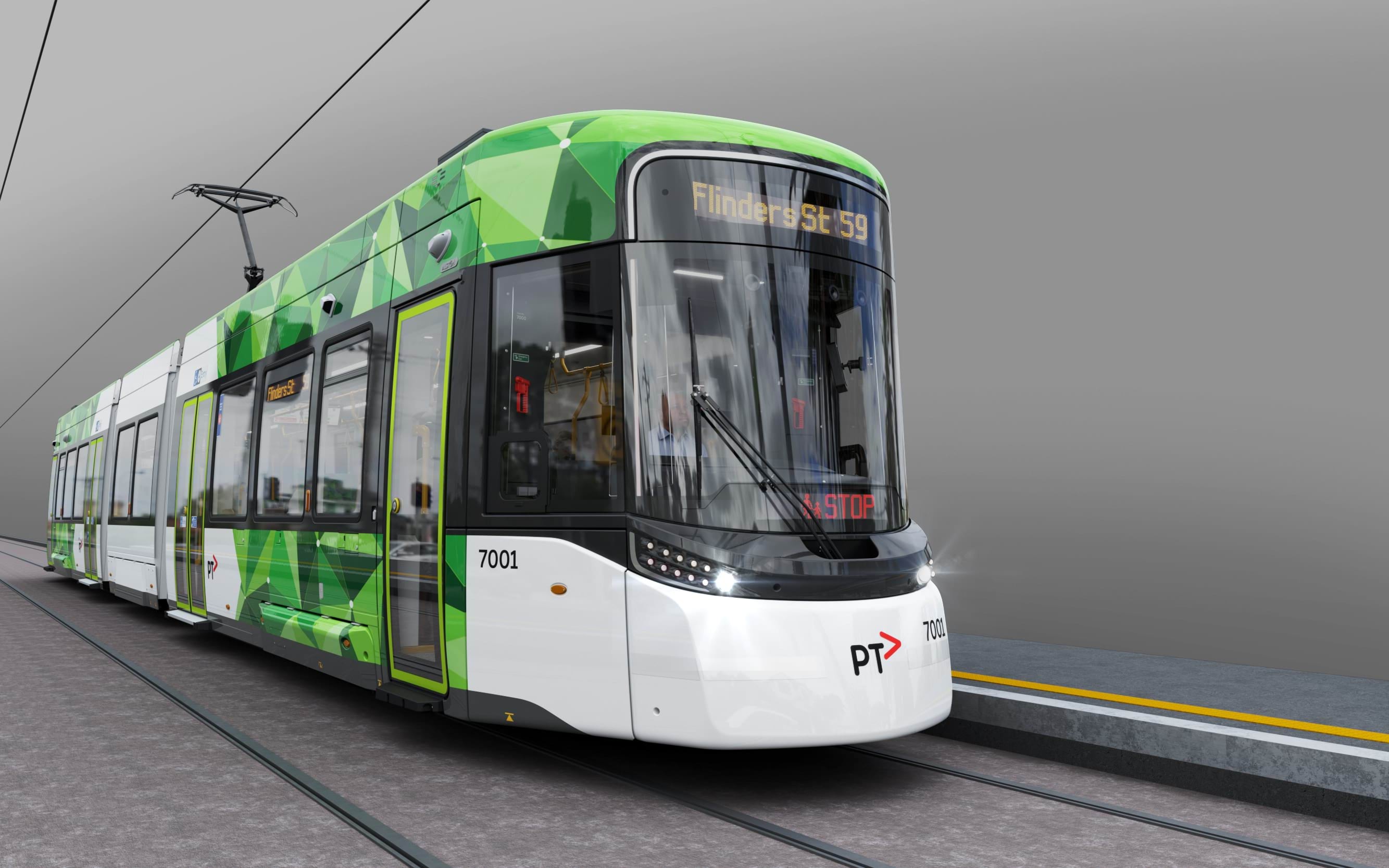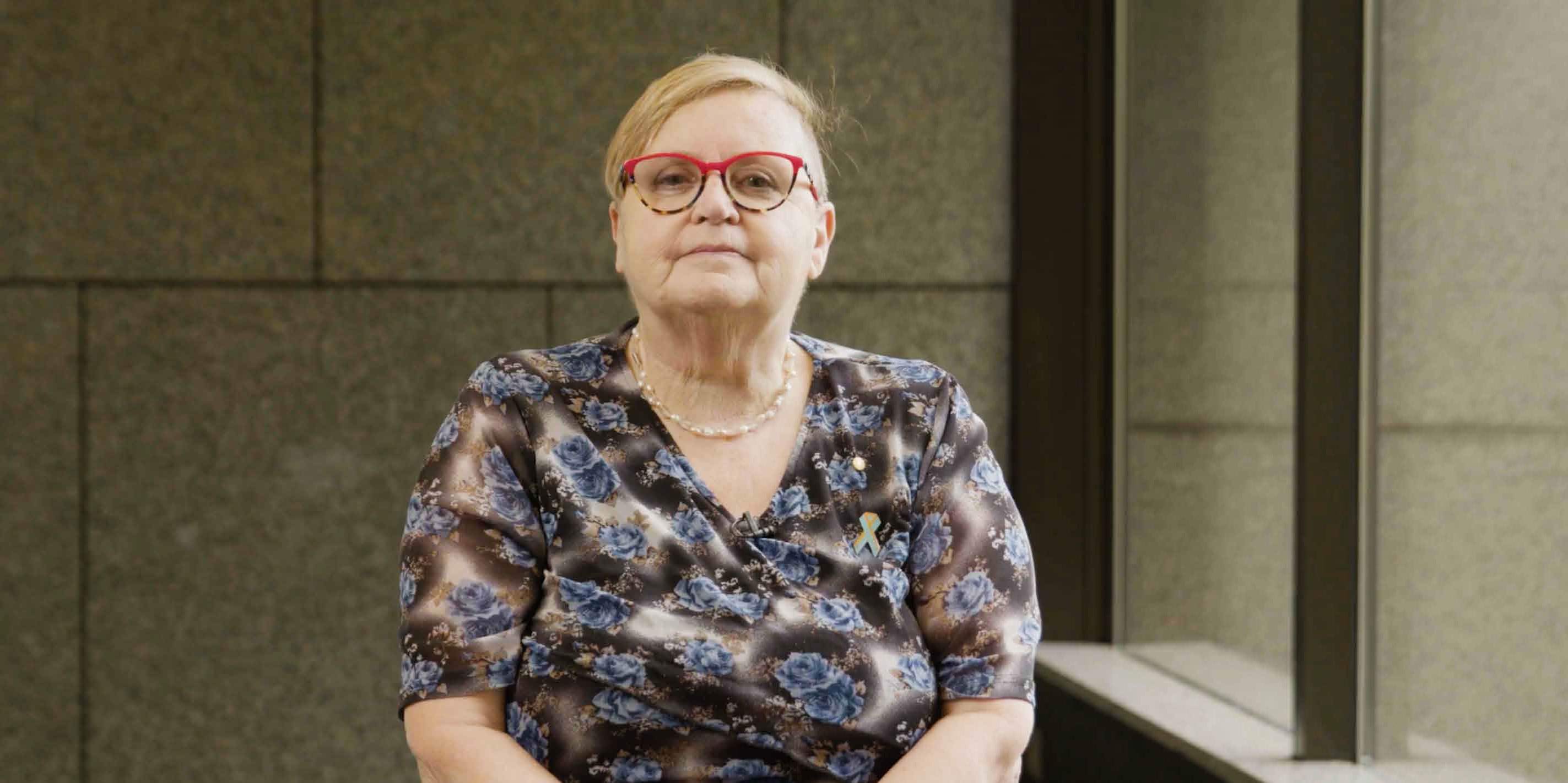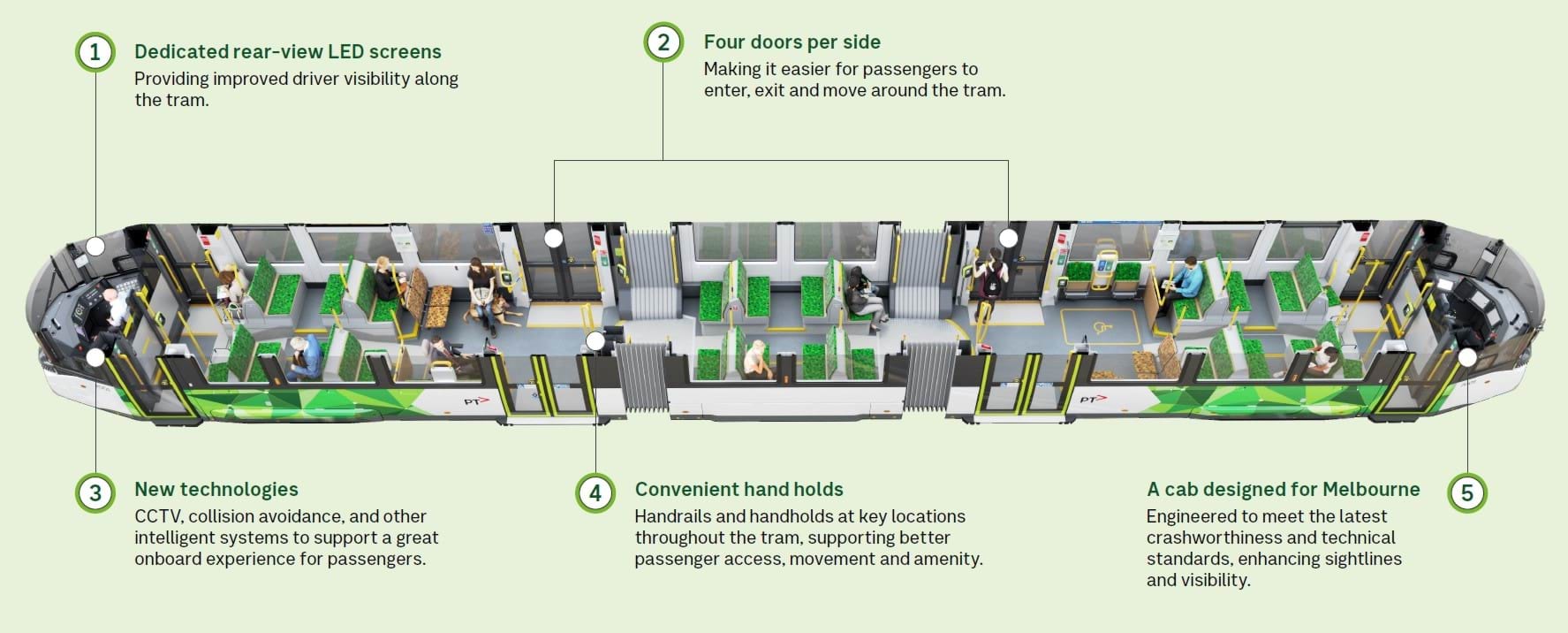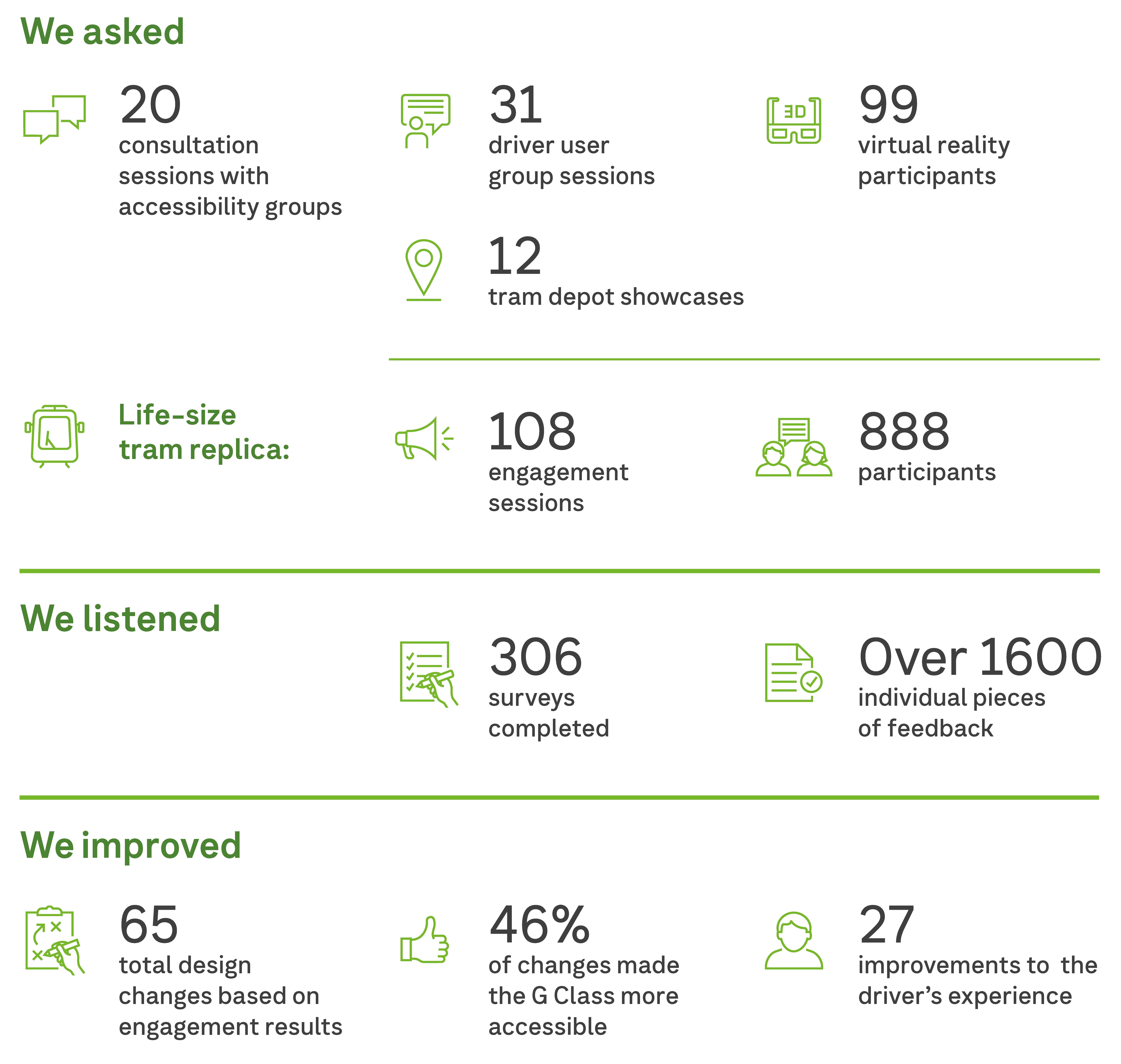A tram for everyone

Featuring a modern design, enhanced passenger comfort, and state-of-the-art technology, the new G Class has accessibility at its heart.
Conversation summary of community engagement to inform design
We worked closely with hundreds of passengers, accessibility advocates, tram drivers and technical experts to create a tram that truly reflects their needs.
Chief Accessibility Advocate Statement
Tricia Malowney OAM is the Chief Accessibility Advocate to the Department of Transport and Planning.

'If we fix public transport for people with disabilities, we fix it for everyone.
I’ve believed this about public transport for as long as I can remember, and I’m pleased to see it shared as a core belief at the Department of Transport and Planning (DTP) as we move forward with Melbourne’s new G Class trams.
In early 2024, I travelled overseas and looked at the experiences of people with disabilities on public transport. I was surprised that the challenges were pretty much the same everywhere: outdated infrastructure, rolling stock designed in less inclusive eras, and managing heritage protection and tight budgets.
Sound familiar?
While different countries have their own solutions, one thing we excel at is community consultation.
Genuine co-design is critical to building a transport system that works for everyone—not just people with disabilities but also older Victorians, parents with prams, and travellers with luggage. Our approach to designing the new G Class trams highlights how we can effectively hear and be informed by these needs and preferences.
The project went to great lengths to ensure a wide group of people reviewed the G Class design, ensuring we gathered insights from diverse lived experiences.
We might not always agree on what ‘better accessibility’ means; but when we come together in a meaningful co-design process like this, we create something much better.
This document shares these conversations, the valuable feedback received, and how the design has been fine-tuned in response, which will make catching the tram easier for everyone.'
As Chief Accessibility Advocate, Tricia’s role is to amplify the voices of people with disabilities and provide timely advice and support to DTP regarding accessibility. Tricia has been instrumental in supporting people with disabilities during the development of the Next Generation Trams.
Introducing the new G Class tram
Featuring a modern design, enhanced passenger comfort and state-of-the-art technology, the new G Class has accessibility at its heart.
We’re excited to introduce the new G Class tram. With a $1.85 billion investment from the Victorian Government, 100 new trams are being built here in Australia, marking the largest order of locally made trams in the country’s history.
A tram for everyone
Featuring a modern design, enhanced passenger comfort, and state-of-the-art technology, the new G Class has accessibility at its heart.
- Space for up to 150 passengers
- Dedicated priority seats and mobility aid spaces
- Enhanced accessibility
- Hearing loops
- New priority seat design
- Improved reliability and energy efficiency
Key principles
- Continuous improvement
Experience and insights gained in earlier projects were used to inform the design of the new trams.
- Better outcomes through design
Using a human-centred design approach, the tram’s design responds to the needs and preferences of passengers and drivers.
- 25-metre-long vehicle
Optimised to run on our network and provide space for more passengers compared to Z and A Class trams.
- Three-section vehicles
Each G Class tram is built with three modules – two end sections for the driver and passengers, and a central section – along with three sets of wheels (‘bogies’). This layout provides plenty of seating and standing room, designed to cater to passengers travelling in both the city and the suburbs.

Renewing our fleet
The new trams mean we can retire some of our longest-serving high-floor trams, including the Z and A classes, helping to make our public transport network more accessible.
The Next Generation Trams contract includes a 65 per cent local content requirement and will support up to 1,900 jobs.
Why the 'G' Class?
For over a century, Melbourne has assigned a class ‘letter’ to each type of tram. As these new vehicles will be our network’s seventh generation of trams, they have been assigned the letter class ‘G’—the seventh letter of the alphabet.
All part of the plan
The new G Class tram is the next step in making our tram network more accessible, as outlined in Melbourne’s Tram Plan. It complements a coordinated approach to delivering more accessible tram routes over the coming years.
At the heart of the Plan is a focus on improving accessibility and safety, moving more people, improving journey times and reliability, better connecting people and places, and delivering value for money.
The Plan identifies the actions we will take to ensure Melbourne’s trams are more accessible, technologically advanced and efficient than ever before.
We will better integrate our tram network with the wider public transport system and the urban environment in which it operates and deliver better passenger experiences through real-time information and technology upgrades.
The new low-floor trams will enter service starting in 2025 and will be more comfortable, accessible and energy efficient. Upgrading tram stops is also a key component of Melbourne’s Tram Plan. Upgraded tram stops also deliver social, economic and environmental benefits for all Victorians by:
- improving access to education, jobs and social opportunities
- reducing greenhouse gas emissions and improving health outcomes by supporting better access to public transport
- mitigating safety incidents between cars and people walking
- enhancing the street environment and sense of place as tram stops become safer, more attractive and easier to use.
A genuine co-design process
We worked closely with hundreds of passengers, accessibility advocates, tram drivers and technical experts to create a tram that truly reflects their needs.
The co-design process was driven by genuine collaboration and a commitment to engagement, ensuring that every voice was heard and every piece of feedback carefully considered. Using a human-centred design approach, we made sure that these new trams meet and exceed the expectations of those who will use them daily.
Voices that shaped the G Class
We consulted with a diverse range of Victorians as part of our stakeholder engagement program.
Our stakeholder engagement program
We have been engaging with Victorians since April 2022 to ensure the new tram meets of everyone.
- April to May 2022
Online engagement workshops with accessibility stakeholders to find out their real-life experiences with earlier tram fleets.
- July 2022
In-person consultation to explore new accessibility technologies in research and development.
- January 2023
In-person consultation and testing with passenger and accessibility groups on front seat design.
- March 2023
360-degree virtual tour of the tram design with Yarra Trams Accessibility Reference Group.
- May 2023
Virtual reality sessions to test the tram layout and accessible spaces with accessibility and driver groups.
- October to December 2023
Life-size tram replica consultation and testing with nearly 900 targeted participants, including drivers, passengers, and accessibility experts.
- June to August 2024
In-person staff showcase at all Melbourne tram depots, providing an update on the new Next Generation Trams and Maidstone Tram Maintenance Facility (TMF).
- Mid to late 2024
A second round of life-size tram replica consultations to review changes from 2023 with targeted stakeholders.
- Across all phases
Regular accessibility and Driver User Group (DUG) consultations.
A life-size G Class replica
In October 2023, we invited participants to experience a life-size physical replica of the new tram (called a ‘mock-up’). This was one-and-a-half carriages long and showcased proposed new features of the G Class tram, including the driver’s cabin, passenger information displays, wheelchair and priority seat areas, stop buttons, driver intercom, safety features, seats and decals.
The Next Generation Tram project team worked with Alstom and others to host nearly 900 stakeholders from October to December 2023.
The replica sessions included:
- Human factors testing
One-on-one sessions with people representing a range of ages, body types and physical abilities, undertaking an extensive evaluation of the replica tram’s passenger or driver features and areas.
- Tram driver testing and evaluation
Tram drivers, operations staff and relevant subject matter experts examined the driver cab and other features.
- Accessibility and passenger evaluation
Passengers, advocates, emergency services representatives and transport subject matter experts examined the overall tram design, including the exterior design, signage, layout, finishes and information systems.
How feedback improved the G Class tram for everyone
Overwhelmingly, all visitors to the NGT replica tram were excited to experience it, with many showing a high level of curiosity and prior knowledge about tram design – including positive and negative design elements from earlier fleets and other light rail networks.
An average of 75 per cent of passenger representatives rated the overall tram design as ‘great’ or ‘good’, while 64 per cent of tram drivers and instructors rated it as great or good.
More than 80 per cent of participants agreed that the standout features were:
- good lighting, with many liking the warmer lighting of three different test tones
- safety, with good visibility throughout the tram
- readable and easy-to-understand printed signage
- easy-to-see digital passenger information display screens
- ‘next stop’ buttons were easy to locate and identify
- sufficient ticket readers on the tram, all in easy-to-reach places
- priority seats and wheelchair spaces with easy access.
Accessibility Participant:
‘I like that there is a single door on each side right at the front and back. It’s a first for Melbourne’s trams and a welcome addition, in my opinion. Plus, it’s kinda cool how they open to the front instead of going backwards like on other low-floor trams.’
General Stakeholder Participant:
‘I’m impressed at how much priority seating is available for people who need it (i.e. people with mobility aids). I also like the single seats right at the front of the tram; I think I’d get some use out of them. I am also glad to see there are a lot of handholds for people who are standing and enough room around these areas.’
Accessibility Participant:
‘Excellent - nice and spacious, and easy to see.'
Secondary School Student Participant:
‘It’s a mad/cool tram. I enjoyed it a lot.’
Non-negotiables on accessibility
We worked closely with passengers with mobility needs to make sure we understood what was most important to them. Their feedback helped shape a tram that’s accessible and easy to use.
These are the priorities and non-negotiables for accessibility that came from those discussions:
- All accessibility needs are equally important
Passengers said every accessibility feature was equally important. The tram should work for everyone, regardless of their needs.
- Consistency across all trams
Clear and consistent ‘Next Stop’ buttons should be standard across the entire fleet.
- Priority seating
There was a strong focus on ensuring priority seating areas were clearly marked with consistent colours and branding and provided enough space for assistance animals and mobility devices.
- Crowding and safety
The design had to consider crowding, how passengers board and exit, and emergency evacuation.
- Human contact
Some passengers needed to be able to interact with drivers or tram staff when they required extra support.
- Clear button distinction
It was important to clearly distinguish between ‘Next Stop’ buttons and those used for driver assistance or the intercom.
- Acoustic environment
The sound levels inside and outside the tram were considered, especially since quieter trams could affect people with vision impairments or who were deaf or blind.
- Inclusive technology
Technology is needed to cater to everyone, offering different ways to interact with the tram’s systems so no one is excluded.
- Onboard safety and stability
Safety while moving around the tram was critical, and stable, non-slip surfaces and clear access to priority areas are essential.
- High-contrast finishes
High-contrast colours on handrails, seats, and floors were essential for people with vision impairments.
- Clear journey information
Passengers relied on clear information to feel confident and safe.
- Tactile signage
Tactile signage and better contrast between accessibility aids and priority seating made a big difference.
- Space for mobility aids
There had to be enough space for passengers with mobility aids to move around comfortably.
New passenger features based on participants’ feedback
- We’ve adjusted the height of handrails and repositioned seat layouts to keep doorways clear and accessible.
- Two sets of seats now face forward and backward and are clearly marked as priority seats, with extra signage to reinforce their purpose.
- Disruption notifications are now more accessible for passengers with hearing difficulties, including those not using hearing loops.
- For passengers with low vision, we improved tram acoustics to make announcements clearer and upgraded ambient lighting near doors for better visibility at night.
- Ticket readers are angled for easier reach by mobility aid users, and emergency intercoms and door release mechanisms are now at accessible heights.
- Intercoms and stop-request buttons have also been added near priority seating areas for added convenience.
- Doorway lighting is upgraded to improve night visibility, and we’ve added bright, animated lights on door buttons to help passengers locate them more easily.
- Accessibility enhancements in flexible seating include companion seating in wheelchair spaces and safer handrail placements to prevent trips.
- Additional floor contrast makes ramps, turntables, and any level changes easier to spot.
- Passenger information displays (PIDs) now use high-contrast colours for easier reading, and hearing loop decals are more visible across the tram.
- For better emergency readiness, Help Points have been lowered and cleared of obstructive rails.
- We enhanced real-time route information, added clearer signage to manage space near the driver’s door, and optimised the tram’s seating materials and design for comfort and durability.
Driver insights
We established the NGT Driver User Group (DUG) early in the design development to consult and test the design of the tram’s cab. From 2021, tram drivers, health and safety representatives (HSRs), Rail, Tram and Bus Union (RTBU) delegates, depot managers and driver trainers were invited to participate. DUG members represented the depots that will initially operate the G Class trams: Essendon, Kew, Southbank and the CBD Tram Hub.
This group provided a forum for members and other DTP and Yarra Trams staff, including engineering, safety, operations, human factors and accessibility leads, to:
- actively participate in the design review process of the NGT by providing feedback for consideration by DTP and Alstom
- provide input into the design of the NGT at key points during the design and development phases
- ensure that HSRs and employee representatives from designated working groups have their say.
Approximately 70 drivers, driver instructors, and operations professionals with driving experience from across Yarra Trams attended the replica engagement sessions, with 62 participants completing the driver survey. These sessions were invaluable for ensuring the final design of the cab was ergonomic, intuitive and a user-friendly driving experience.
Updates to driver features based on participants’ feedback
- The driver’s cab door was moved to the left side to facilitate easier access for drivers entering and exiting the cab.
- To make operational communications more efficient, we’ve added a second window on the left side of the driver’s cab.
- The layout of push button controls on the armrests was refined based on driver feedback for easier access, and door operation buttons were moved to reduce cramped arm positioning.
- We adjusted the Master Controller’s angle, making it more user-friendly for drivers during operation.
- Full block-out blinds replaced the previous semi-sheer material, improving visibility and comfort for drivers.
- We’ve enhanced the driver’s seat to allow for easier adjustments, ensuring that drivers can find their optimal seating position quickly.
- The Automatic Vehicle Monitoring system interface was enhanced for better usability, ensuring drivers could efficiently interact with its features in the new tram environment.
- Additional emergency stop buttons were added in more convenient locations for quicker access during operation.
Thank you
This project reflects our shared commitment to creating a more inclusive future for public transport. Thank you for shaping it with us.
Thank you to everyone who participated in the extensive stakeholder engagement program.
Your feedback directly influenced the final design of the Next Generation G Class tram, helping to make Melbourne’s tram network more accessible for everyone.
Update - November 2024
Manufacturing is now underway at Alstom’s Dandenong facility, and we look forward to the trams’ debut on our network in 2025 as testing begins. The full fleet of 100 trams will roll out progressively in the coming years.

